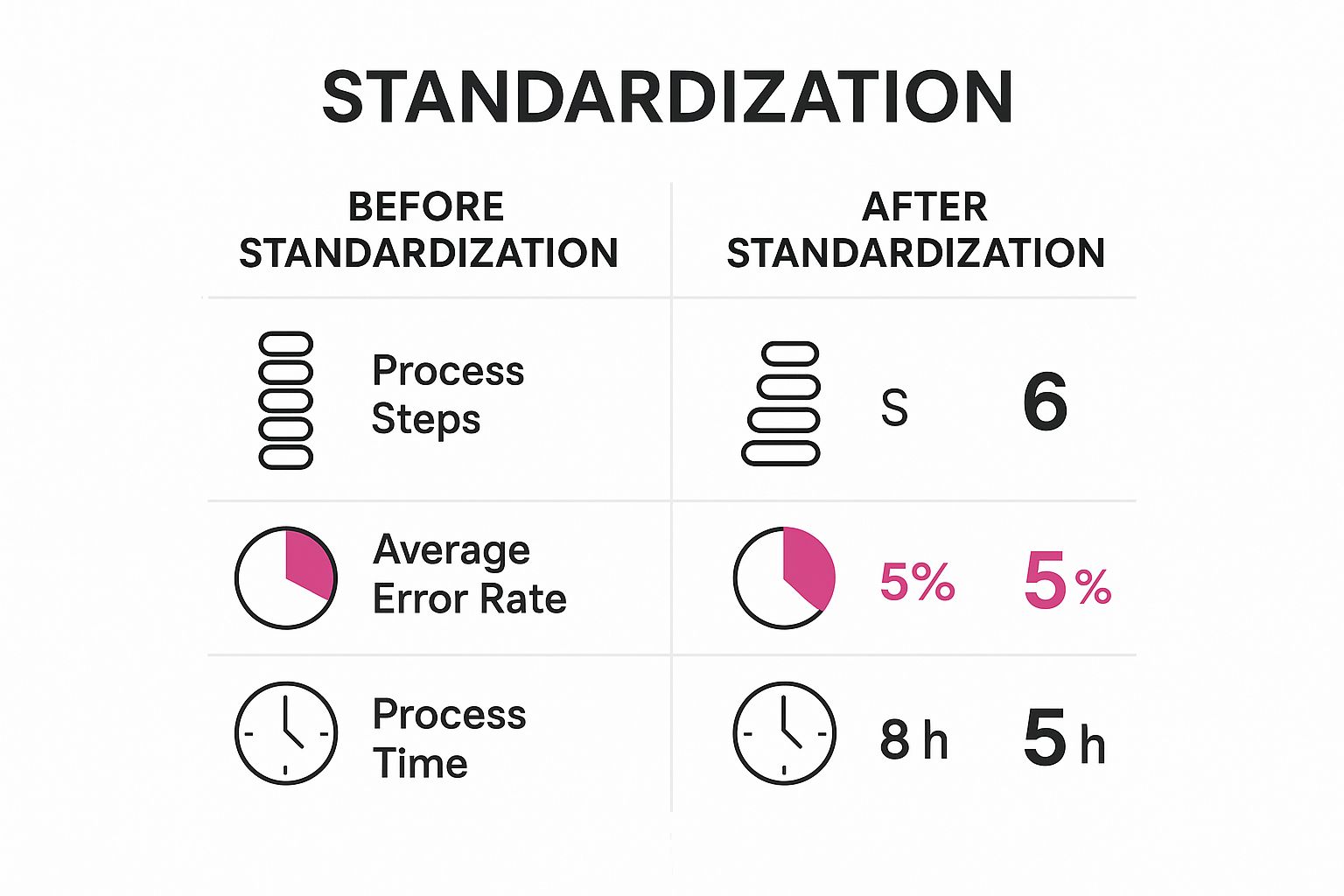Table of contents
Let's be honest, "streamlining business processes" can sound like a bit of corporate jargon. But what it really means is getting smart about how you work. It’s about cutting out the wasted effort, ditching the clunky manual tasks, and building smoother, faster ways to get things done.
Think of it as swapping out old, inefficient habits for smart, automated systems that boost productivity and create consistency across your whole operation.
Why Streamlining Is a Growth Engine, Not a Cost Centre
Many Australian SMEs fall into the trap of seeing process improvement as just a cost-cutting exercise—something you do when the budget gets tight. But that view is incredibly shortsighted. Truly streamlining your business isn't just about saving a few dollars here and there. It's a strategic investment in growth, resilience, and carving out a real competitive edge. It's how you build a business that's ready to adapt and thrive, not just survive.
Once you make that mental shift, everything changes. When your operations run like a well-oiled machine, you unlock benefits that directly fuel your growth. It’s a key part of improving operational efficiency and turning your internal systems into a powerful asset.
The Real Pressures on Australian SMEs
For small and medium businesses across Australia, the pressure is well and truly on. We’re all feeling the pinch of rising operational costs, grappling with labour shortages, and trying to meet ever-increasing customer expectations. In this climate, a workflow that was merely "a bit annoying" last year can quickly become a major roadblock to growth.
Sound familiar? You've probably seen these scenarios play out:
- Wasted Staff Hours: Your team is burning hours every week manually punching invoice data into your accounting software. That's time they could be spending on things that actually make you money, like talking to customers or closing sales.
- Delayed Projects: A new client is ready to go, but the project is stuck in limbo. Why? Because the onboarding process involves chasing people for signatures over email, delaying the start of that all-important revenue-generating work.
- Inconsistent Service: A customer has a problem, but without a clear, standard procedure, every complaint is handled differently. This leads to unpredictable results and can seriously damage your hard-earned reputation.
These small frictions might seem minor on their own, but they add up. They create a significant drag on your business's momentum and, ultimately, your bottom line.
Introducing Business Process Management (BPM)
This is where a more structured approach, known as Business Process Management (BPM), can be a game-changer. BPM isn't just a fancy acronym; it's a formal way of looking at your workflows to discover, analyse, measure, and improve them. It provides a solid framework for moving from chaotic, "make-it-up-as-you-go" tasks to organised, efficient systems.
There's a reason the adoption of BPM is picking up speed in Australia. The market is projected to skyrocket from USD 451.2 million in 2024 to USD 982.4 million by 2033. This growth is being driven by SMEs just like yours, searching for effective ways to fight back against rising costs. If you're interested, you can dig into the full analysis on this growing BPM market trend.
Adopting a BPM mindset means you stop asking, "Is this getting done?" and start asking, "Is this getting done in the best possible way?" It reframes process improvement from a chore into a continuous strategy for creating value.
Ultimately, streamlining your business is about empowering your team. It's about giving them better tools and clearer processes so they can focus on doing their best work. When that happens, you deliver more value to your customers with less friction, turning your operations from a necessary cost into a powerful engine for sustainable growth.
Finding the Friction in Your Daily Operations

Before you can start fixing and automating, you have to get brutally honest about where things are breaking down. You can't solve a problem you don't fully understand, and most of the time, inefficiencies are hiding in plain sight, disguised as "the way we've always done things." This is where a hands-on audit is your best friend.
The whole point is to swap out assumptions for actual clarity. You might feel like your client onboarding process is clunky, but where’s the real bottleneck? Is it getting the initial contract signed? The internal handover between your sales and delivery teams? Or that final welcome email that always seems to get forgotten? Pinpointing the exact source of friction is the only way to find a real solution.
Visualise Your Workflows
One of the best ways I’ve found to uncover these hidden problems is to map your processes visually. Don't worry, this doesn't have to be complicated. You can use a whiteboard, some sticky notes, or even a free online flowchart tool. The idea is to create a simple, step-by-step diagram of a workflow from start to finish.
Pick a core process that really moves the needle for your business. Good places to start are often:
- New Client Onboarding: From the moment they say "yes" to when you kick off the first project.
- Accounts Payable Cycle: From receiving a supplier's invoice to the final payment confirmation.
- Customer Support Tickets: From when a client first flags an issue to the moment it's marked as resolved.
When you map it out, you create a tangible picture of every single touchpoint, handover, and decision. This visual perspective makes it so much easier to spot redundant tasks, unnecessary delays, and frustrating bottlenecks that are otherwise invisible in the day-to-day chaos.
Talk to Your Team on the Front Lines
Your employees are your secret weapon for finding operational friction. They’re the ones in the trenches, dealing with these processes every single day, and they know exactly where the roadblocks are. They're the ones getting frustrated by clunky software, double-handling data entry, and confusing handovers.
Don’t just ask your team what’s wrong. Ask them about their "workarounds"—the unofficial tricks and steps they use to get the job done despite the broken process. These workarounds are a goldmine, pointing you directly to the biggest points of failure.
Getting this feedback is non-negotiable. You could hold a quick workshop or just have a few one-on-one chats. The key is to create an environment where people feel safe giving honest feedback. This raw input, when combined with your process maps, gives you the full picture of what actually needs fixing. This approach is also crucial when you want to manage customer feedback properly, as both staff and client insights tell the real story of your operations.
I saw this in action with a Perth-based digital agency recently. They discovered their project managers were spending nearly five hours a week just manually creating and sending status reports to clients. It was a task everyone just accepted as part of the job. By identifying this massive time sink, they found a project management tool to automate the reporting, instantly freeing up 20 hours per month to spend on high-value client strategy work instead. A huge win.
Using Automation to Boost Operational Agility

Once you've pinpointed the friction points in your day-to-day operations, technology can be your best mate. This is where you can really sharpen up your business processes, moving beyond just managing tasks and into full-blown automation. It's not about replacing your team; it’s about giving them the right tools to handle the repetitive, mundane work that eats up their valuable time.
This is where Digital Process Automation (DPA) comes in. Think of it as the conductor of an orchestra, making sure every single task, approval, and data transfer happens exactly when it should.
And it’s taking off. The global workflow automation market is tipped to hit $26 billion by 2025—a huge leap from just $5 billion back in 2018. For Aussie businesses, this is a golden opportunity to get everything in sync, from processing invoices to qualifying new leads.
Beyond Just Ticking Boxes
Proper automation does a lot more than just check tasks off a list. It knits together different parts of your business that were once working in isolation, creating a smarter, smoother flow of work. The real magic is how it speeds things up while cutting down the risk of human error.
Just imagine these scenarios for a local Aussie business:
- An accountant gets an invoice in their inbox. Instead of manually downloading it and punching the details into Xero, an automation kicks in. It reads the invoice, pulls out the key info, drafts a bill, and sends it to the right person for approval—all within seconds.
- A mortgage broker gets a new lead through their website. An automated workflow immediately shoots off a personalised welcome email, adds the contact to their CRM, and sets a follow-up task. No lead ever gets lost in the shuffle.
- A car detailer finishes a job. A few days later, their system automatically sends a friendly thank-you message with a link to leave a Google review, without anyone lifting a finger.
These examples show how automation handles the grunt work, freeing up your crew to focus on the strategic stuff that actually brings in revenue. For a closer look at how this can transform your sales workflows, it's worth exploring the benefits of sales process automation.
The aim of automation isn't just to get things done faster. It’s about building a more resilient, agile business where data is spot-on, processes are consistent, and your team is freed up to do their best work.
Unlocking Smarter Decisions
One of the most valuable—but often overlooked—benefits of automation is the data it gives you. When all your processes run through one central system, you get an incredible view of your entire operation. You can finally get clear answers to some pretty critical questions.
Key Questions Automation Helps Answer
- Where are our biggest bottlenecks? You can see exactly how long each step in a workflow is taking.
- Are we meeting our service goals? Track response times for customer enquiries automatically.
- Which team members need more support? Pinpoint where workflows are getting stuck or delayed.
This data provides powerful insights that were almost impossible to get before, helping you make sharp, informed decisions to fine-tune your operations. This is also crucial for your brand's reputation; our guide on online reputation management for small business explains how consistent, efficient service builds trust. By putting the right tools in place, you don't just improve speed—you build a more professional and reliable experience for your customers.
How to Choose the Right Automation Software
Picking the right software is crucial for actually getting results from automation. The market is absolutely flooded with options, from massive, all-in-one Business Process Management (BPM) platforms to nimble, specialised apps. For an Australian SME, the secret is to find a tool that solves your specific problems without piling on unnecessary complexity or cost.
This decision is only getting more important. The Asia Pacific region is seeing huge growth in Business Process Automation software, with Australia holding an 8.03% market share in a global industry expected to hit $15.33 billion by 2025. More choice is great, but it can also lead to more confusion.
Evaluate Core Needs Before You Shop
Before you even glance at a single product website, you need to get crystal clear on what you actually need the software to do. It’s easy to get distracted by flashy features you’ll never end up using.
Start by asking these fundamental questions:
- What's the single biggest bottleneck we need to fix? Are you trying to speed up invoicing, improve client onboarding, or automate marketing follow-ups? Zero in on tools that excel at solving that one core problem first.
- Who on my team will be using this? A tool is completely useless if your team finds it too complicated to use. User-friendliness is non-negotiable. If it’s not intuitive, it won’t get adopted, and you’ve just wasted your investment.
- What systems do we already use? Your new software must play nicely with your existing tech stack. For many Aussie businesses, seamless integration with accounting software like Xero or MYOB is a total deal-breaker.
This initial soul-searching helps you build a practical checklist of "must-have" features versus "nice-to-have" extras. It makes the whole decision-making process much clearer. As you figure out how to choose the right automation software, looking into the top no-code automation tools can also give you some great, accessible options for organising your workflows.
Comparing Automation Software Types for Your SME
To help you get a clearer picture of the landscape, here's a quick comparison of the main categories of automation software. This should help you figure out which bucket your business's needs fall into.
This table is a starting point. The key takeaway is that you don't always need the biggest, most expensive tool. Often, a specialised app is the smartest, most cost-effective first step.
Scalability and Specialisation
Another key point to mull over is whether you need a broad platform or a specialised app. A comprehensive BPM suite can manage incredibly complex, interconnected workflows across your whole organisation, but it can also be seriously expensive and demand a huge amount of setup time.
On the flip side, specialised tools—like Testimonial Donut for review collection or a dedicated social media scheduler—do one thing, and they do it exceptionally well. These are often much more affordable and easier to get up and running, giving you a faster return on your investment.
For most SMEs, the best approach is to start small. Pick a specialised tool that solves an immediate, high-impact problem. As your business grows and your needs change, you can then look at how to connect these tools or graduate to a more comprehensive platform.
Just look at the impact standardising a single process can have. This infographic shows how it affects key metrics like the number of steps, errors, and time spent.

The data here is pretty stark. Even a simple standardisation can slash process time and error rates, proving the immense value of targeted improvements. Making an informed software choice is your first real step toward getting these kinds of results and building a more efficient, resilient business.
Implementing and Refining Your New Workflows

Alright, you've mapped out a solid plan and picked the right software. That's a huge step. But the real test starts now, when you roll out these new and improved workflows to your team. Success here really boils down to two things: how well you manage the change with your people, and how you measure the impact of all this hard work.
Just announcing a new process and hoping everyone gets on board is a classic mistake. I’ve seen it happen. People aren't trying to be difficult; they're just comfortable with what they know. Your job is to make this shift feel less like a disruption and more like an upgrade, using clear communication and real support.
Getting Your Team Onboard
The first thing you need to do is explain the "why." Don't just show them a new dashboard or a flowchart. Talk about the headaches you're trying to solve. Frame it in a way that matters to them, like cutting down on that soul-crushing manual data entry or finally getting rid of those confusing handovers between departments.
To get this right, you’ll need to focus on:
- Clear Communication: Tell them exactly what's changing, why it's changing, and—most importantly—how it will make their jobs easier.
- Practical Training: Run hands-on training sessions. Ditch the slide deck and let them actually use the new tools in a safe, controlled environment.
- A Feedback Loop: Give your staff a simple way to ask questions or flag issues as they get used to the new system. This turns them from spectators into active participants.
Process improvement isn't a top-down mandate; it's a team sport. When your employees feel heard and actually understand the purpose behind the change, they're far more likely to get on board and help make it a success.
When you nail the human side of things, you build momentum and ensure your efforts to create better business processes actually stick.
Measuring What Matters
You can't improve what you don't measure. It's a cliché for a reason. To know if your new workflows are actually working, you need to track a few simple Key Performance Indicators (KPIs). Don't overcomplicate this.
Just think back to the original problem you wanted to solve, and measure that. For instance:
- Reduced Task Time: If your goal was to speed up invoicing, track the average time it takes to get from invoice receipt to payment.
- Lower Error Rates: If manual data entry was causing a mess, monitor the percentage of errors before and after you made the change.
- Increased Output: For a review collection process, you could measure the number of new testimonials gathered each month. If you need a hand with this, our guide on how to get more customer reviews has some great tips.
Creating a Culture of Continuous Optimisation
The most successful businesses I've seen treat process improvement as a continuous cycle, not a one-and-done project. The goal isn't to hit perfection on day one. It's about making small, steady improvements over time.
Encourage your team to always be on the lookout for small friction points or new bottlenecks. Make it a habit to review your KPIs and ask, "What's one small thing we could tweak this month to make this even better?" This mindset weaves optimisation into your company's DNA, making sure your business stays sharp and efficient as you grow.
Frequently Asked Questions
Diving into process improvement can stir up a few questions, especially for Aussie SME owners who are always juggling time and budgets. Let's walk through some of the most common ones I hear, so you can move forward with confidence.
What Is a Realistic Budget for Automation?
This is usually the first question people ask, and honestly, the answer is better than you might think. You don't need a huge war chest to get started. The cost to streamline business processes really comes down to the complexity of the problem you're trying to fix.
You can find plenty of powerful, specialised automation tools that start from as little as $50 to $150 per month. These are brilliant for targeting very specific, high-impact pain points—like automating your social media schedule or, in our case, getting customer reviews on autopilot.
The real trick is to shift your thinking from upfront cost to return on investment. If a $100-a-month tool saves your team five hours of soul-crushing manual work every single week, you're already winning by a long shot.
My advice? Start small. Pick one affordable tool that solves a genuine, nagging problem. Once you see the value, you can reinvest the time and money you've clawed back into fixing the next bottleneck.
Which Business Areas Should I Improve First?
With so many moving parts in a business, it’s easy to feel a bit lost on where to begin. The smartest move is to find the low-hanging fruit—the areas that will give you the biggest "bang for your buck" right away.
For most small to medium businesses, these are almost always the departments drowning in repetitive, manual tasks:
- Finance and Admin: Just think about invoicing, chasing payments, logging expenses, and running payroll. Automating the data entry here can slash errors and free up a surprising number of hours almost instantly.
- Customer Service and Follow-up: This covers everything from responding to that first website enquiry to asking for feedback after you've finished a job. Consistency is everything in the customer journey, and automation makes sure no one ever falls through the cracks.
Hitting these areas first usually delivers the most obvious and immediate wins, which builds great momentum for whatever you decide to tackle next.
Can I Organise Processes Without Expensive Software?
You absolutely can. While software is a fantastic accelerator, the real foundation to streamline business processes is clarity and consistency—and you can start building that for free.
Just begin by mapping out your core workflows. Seriously. Grab a whiteboard or a free online tool and draw out the step-by-step process for something like onboarding a new client. I guarantee this exercise alone will show you obvious weak spots or redundant steps you can ditch immediately.
Creating simple checklists and templates for your most common tasks also forces consistency, and it won't cost you a cent.
Ready to take the manual work out of your testimonial and review collection? See how Testimonial Donut can put your reviews on autopilot, save you precious time, and help you build powerful social proof without the hassle. Get started with Testimonial Donut today.



